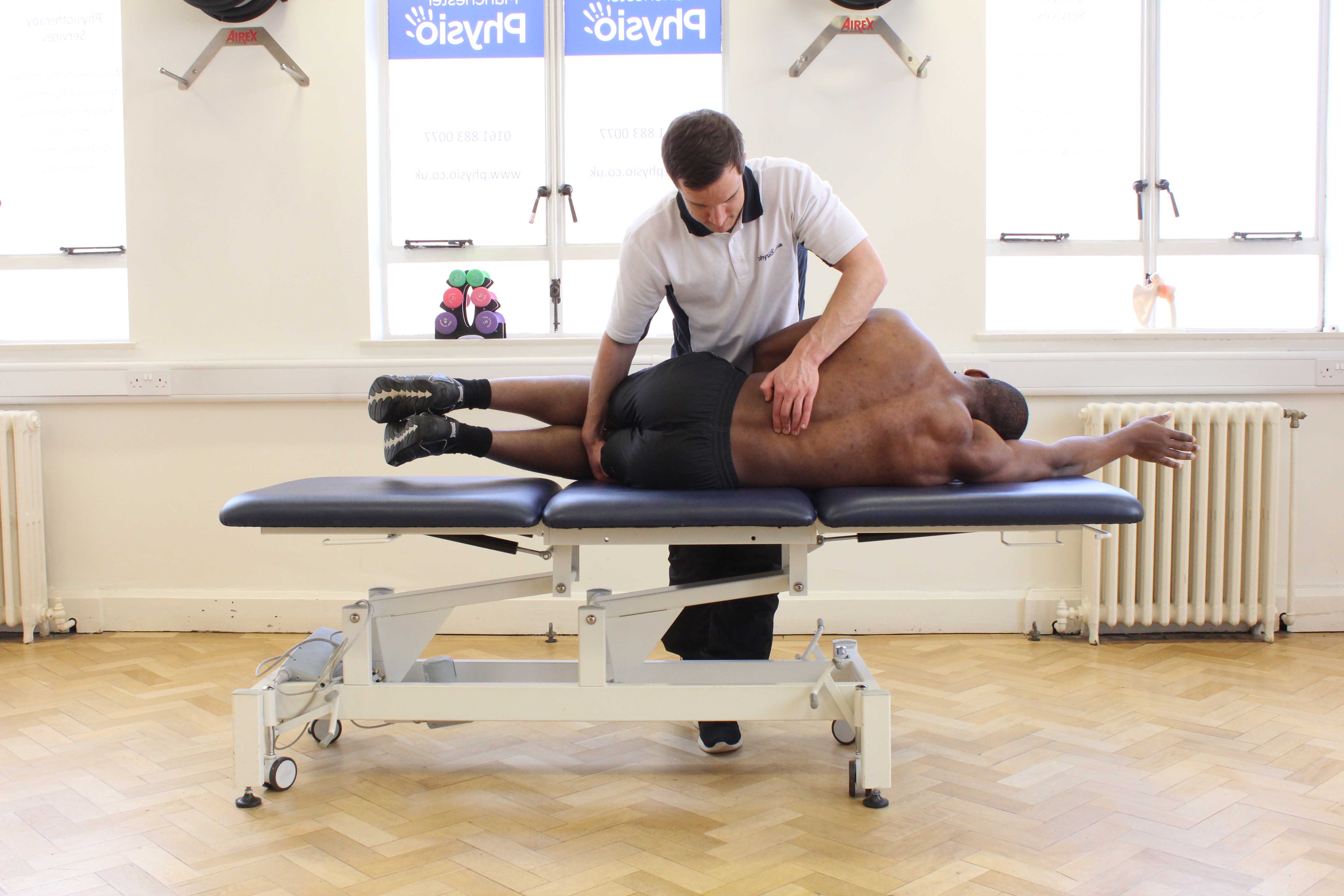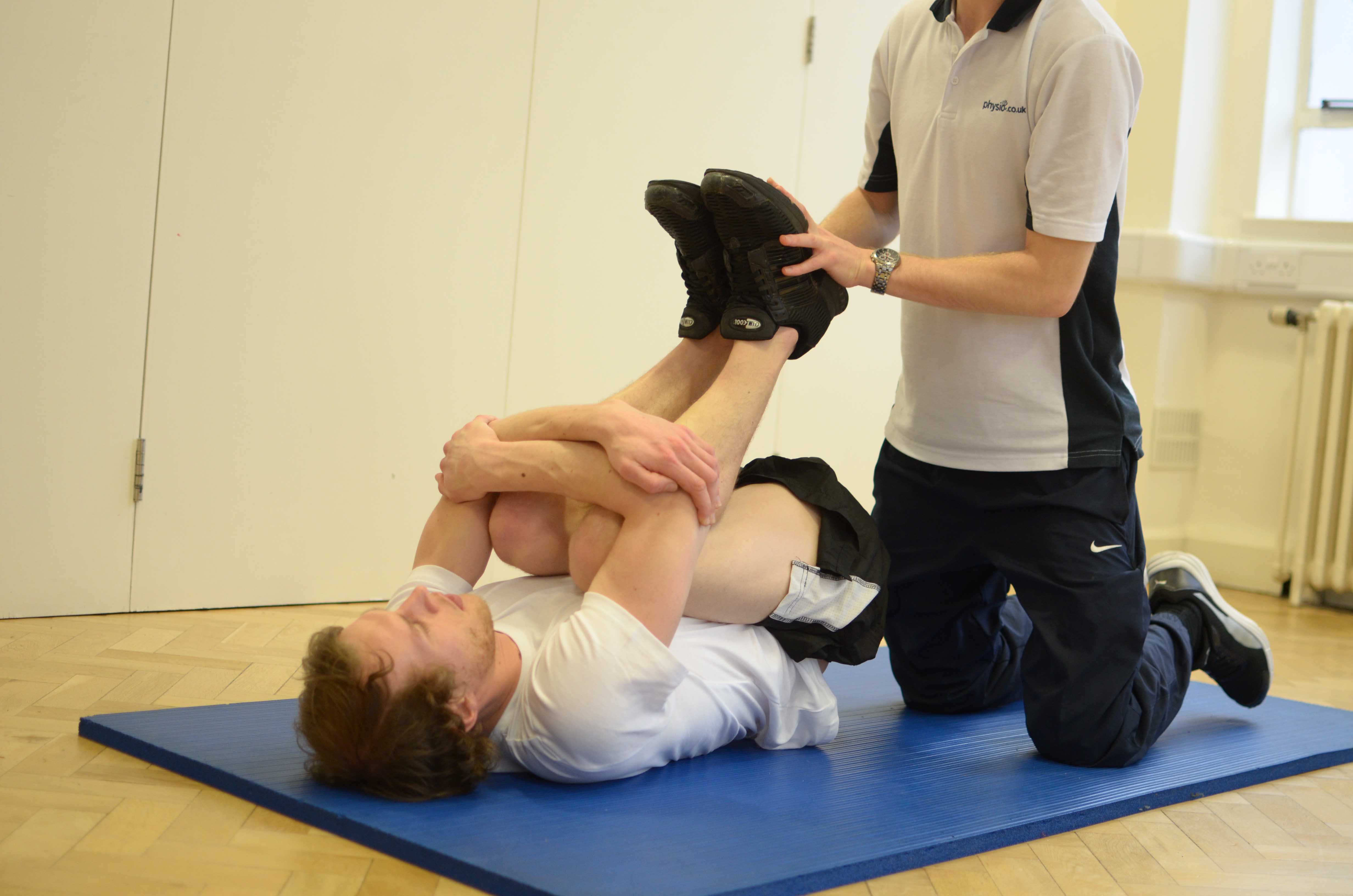Cervical decompression
Cervical decompression surgery is a general term that refers to various surgical procedures intended to relieve symptoms caused by pressure or compression, on the nerve roots and spinal cord in the cervical spine. Bulging or collapsed disks, thickened joints, loosened ligaments and bony growths can narrow the space in the spinal canal and irritate and inflame the nerve roots. This can cause pain, loss of movement, numbness, tingling and muscle weakness.
 Above: Stripping massage of the trapezius muscle by MSK therapist
Above: Stripping massage of the trapezius muscle by MSK therapistSurgical techniques in a cervical decompression may include a laminotomy, foramiotomy, osteophyte removal and fusion of the vertebrae to relieve pressure (decompress) from the affected area.
- A laminotomyinvolves removing part of the lamina (bony arches of the spinal canal).
- A foraminotomyinvolves increasing the opening containing the nerve roots that exit the spinal cord by removing bone or tissue.
- Osteophyte removal involves removing bony growths called osteophytes or bone spurs.
Physiotherapy before a cervical decompression
Before your operation it is important to remain active and continue with stretching and range of movement exercises. Physiotherapy will maintain your muscle strength and flexibility in your neck to prepare you for your surgery and help you recover following your operation.
 Above: Passive stretch of the trapezius muscle in the neck by experienced therapist
Above: Passive stretch of the trapezius muscle in the neck by experienced therapistSymptoms after a cervical decompression
After your surgery, you will have some discomfort or pain but medication will help you to control any pain you may have. A physiotherapist will usually visit on the first day after your operation to help you out of bed and show you the correct way to move safely. The usual length of stay in the hospital for cervical decompression varies from one to four days. Your physiotherapist will provide you will some exercises for you to continue at home and will show you how to mobilise and transfer safely and effectively.
Physiotherapy following a cervical decompression
At Physio.co.uk, we offer specialised and individualised treatment for individuals following their decompression surgery. Physiotherapy treatment at Physio.co.uk willenhance your independence with everyday activities and improve your physical capabilities such as your mobility and hand function. Your physiotherapist at Physio.co.uk will set short and long term treatment goals at the centre of your rehabilitation so that you can monitor your progress so that you reach your maximum physical potential. Following your surgery, physiotherapy treatment at Physio.co.uk will improve your quality of your life by facilitating your recovery and getting you back to a level you were previously.
1-2 weeks
Shortly after your surgery, your physiotherapist at Physio.co.uk will concentrate on increasing your comfort when moving and reducing any inflammation that you may have. Physiotherapy treatment at this stage may include gentle range of movement exercises and advise about transfers and posture to prevent stiffness, ease pain and make sure you are comfortable. Ultrasound may be used to reduce any inflammation and promote healing. Physiotherapy treatment in the first couple of weeks will relieve pain and inflammation and improve range of movement. Advise about lifting reaching and bending activities will be given to make sure your neck is in a safe position. Physiotherapy treatment at this stage will include:
- Gentle active range of movement neck exercises
- Ultrasound
- Advise about posture and movement
2-6 weeks
Physiotherapy treatment at this stage of your recovery will improve your confidence with movement by showing you exercises to help strengthen the muscles with support your neck. A progressive exercise programwill begin to introduce daily stretching and gentle strengthening activities for muscles in your neck, shoulders, and upper back. Walking and stationary cycling are ideal low impact exercises to improve your ardiovascular fitness without increasing discomfort.Physiotherapy will also monitor how you move around your home and transfer effectively, for example, getting in and out of bed, in and out of the shower/bath and up and down the stairs.
You may be able to return to light work within two to three weeks, however high impact and contact sports should be avoided until healing has occurred. Individuals with heavy manual jobs will be advised to wait longer to return to work usually up to 3 months. Physiotherapy activities at this stage may include:
- Active and passive range of movement exercises in the neck, upper back and shoulder.
- Stretching exercises to increase flexibility
- Walking
- Stationary cycling
6 -12 weeks
Progression of exercises will be a fundamental part of your rehabilitation at this stage. Your exercise program will continue to strengthen the muscles around your neck, shoulder and upper back and improving your flexibility. As you continue to improve, your physiotherapist will tailor the exercises to your lifestyle, in order to promote your return to work and sporting activity. Your physiotherapist may also suggest ways to correct posture and positioning at home or at work.Physiotherapy treatment at this stage may include:
- Neck and abdominal strengthening exercises
- Progressing walking distance
- Exercises based around your work or sporting life
- Correcting and varying posture
12+ weeks
Physiotherapy treatment 3 months after your surgery will help you to make more long term improvements and enhance your confidence with the activities important to you.
The amount of time it takes for you to get back to a level you were previously will depend on your individual circumstance and commitment to you rehabilitation. Our motivated team of physiotherapists at Physio.co.uk will facilitate your recoveryby getting you back to work or sporting activities as soon as possible.
For more information call Physio.co.uk now on 0330 088 7800 or to book an appointment please contact us.

 0330 088 7800
0330 088 7800

































